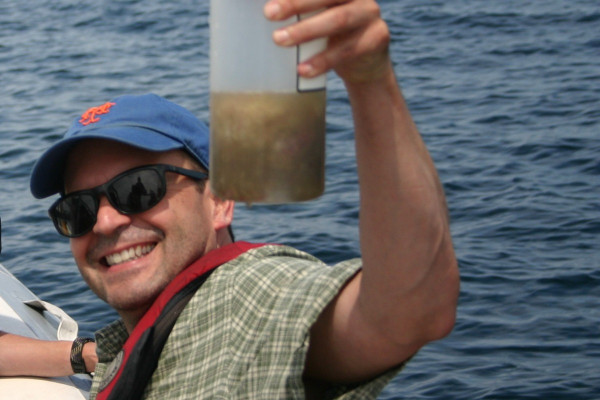
Marine scientist Dr. Joe Roman holds nitrogen-rich whale excrement collected from a humpback whale in the Stellwagen Bank National Marine Sanctuary. Courtesy of David Wiley.
By David Wiley, Phd
Marine mammals eat fish, so more marine mammals equal fewer fish, right? And since fishermen want lots of fish, more marine mammals are bad news for fishermen, right?
New research led by Stanford University’s Matt Savuca, involving a team of scientists from Stellwagen Bank National Marine Sanctuary, is showing that things are not that simple: hungry whales actually feed the ecosystem.
Believe it or not, it looks like more whales could mean more fish!
The first indication of this counter-intuitive idea came from southern oceans. Krill — two-inch, shrimp-like animals (zooplankton) — are the main food for baleen whales and everything else around Antarctica. Killing more than two million baleen whales between 1915 and 1970 was predicted to result in a huge increase in the krill population, because the whales that ate them were gone. Instead, the krill population dramatically declined. That’s right; fewer krill-eating whales resulted in less krill, not more.
How could that be?
Scientists are piecing together this puzzle, revealing the beauty and complexity of the ocean system.
The ocean food web starts with phytoplankton, tiny marine organisms that are eaten by zooplankton such as krill, which are then fed upon by whales, seals, fish and seabirds. So it all starts with phytoplankton.
But phytoplankton need sunlight and nutrients from seawater to live and reproduce, and in the southern oceans, iron is an essential nutrient that is in short supply.
Enter the whales.
A single giant blue whale in Antarctica can eat over 16 tons of krill in a day, the caloric equivalent of 30,000 Big Macs. That’s a lot of food that results in a lot of excreted fecal material (whale poop).
Whale fecal matter contains iron because whales feed on iron-rich food deep in dark ocean waters. But they tend to excrete at the surface. Therefore, whale feces moves iron from deep waters and spreads this fertilizer along the sunlit ocean surface, where phytoplankton use it to live, grow and power the food web.
When whales were virtually eliminated from the Antarctic system, this nutrient recycling system was broken, resulting in less krill and everything else; scientists estimate that prior to whaling, whales alone ate more than twice the amount of krill that exists in those waters today: Less whales, less fecal material, less iron, less krill, less everything.
But Antarctica is far away. Could something similar be happening in the North Atlantic and even in the waters off Chatham?
During pre-Colonial times, New England waters teamed with marine mammals and fish. Today many marine mammals are endangered or exist at levels far below those early days. Fish populations are also diminished, leaving fishermen with reduced catch and increased regulations.
While some people blame overfishing, could an impoverished ecosystem caused by a lack of marine mammals be a contributing factor? Could more marine mammals actually mean more fish for fishermen?
In 2008 and 2009, we worked with Joe Roman of the University of Vermont to investigate what marine mammals might contribute to the local ecosystem. The results were surprising and important.
Here in the North Atlantic, the ocean has plenty of iron, but nitrogen is a limiting factor, just like in many gardens and farms in New England. Without nitrogen, there is less phytoplankton and zooplankton, and less of everything that depends on them. Joe joined annual whale-tagging trips to Stellwagen Bank National Marine Sanctuary and the waters off Chatham to investigate what he calls “the whale pump.”
Our research had already shown that while surface feeding humpback whales are visually spectacular, most feeding occurs on sand eels on or near the bottom. Would whale excrement recycle or “pump” nitrogen derived from digested sand eels back to the surface and power the local food web?
Once we tag a whale, we follow it to record its surface behavior. When a whale excreted, Joe would collect a sample and compare the amount of nitrogen in the water nearby with water collected away from that site. Sure enough, whales were bringing nitrogen up from the dark bottom, flooding surface waters with this essential element. Feeding whales were feeding the ecosystem.
Joe calculated that whales and other marine mammals provide more nitrogen to the surface waters of the Gulf of Maine than the combined contribution of all rivers that flow into it. They deliver this nutrient when phytoplankton need it most, during the late spring and summer, when waters are warm and stratified. Whales, seals and seabirds move these vital nutrients at the right time and in the right place.
We are living in an impoverished ecosystem, with reduced marine life. Yet the burgeoning body of data suggest that marine mammals, with their huge appetite and resulting load of nutrient-rich excrement, actually create more food than they eat.
We have been using animal waste as fertilizer to increase land productivity for thousands of years. So perhaps this finding shouldn’t be a surprise. At the very least, food for thought.
(David Wiley is the Research Ecologist for NOAA’s Stellwagen Bank National Marine Sanctuary)
